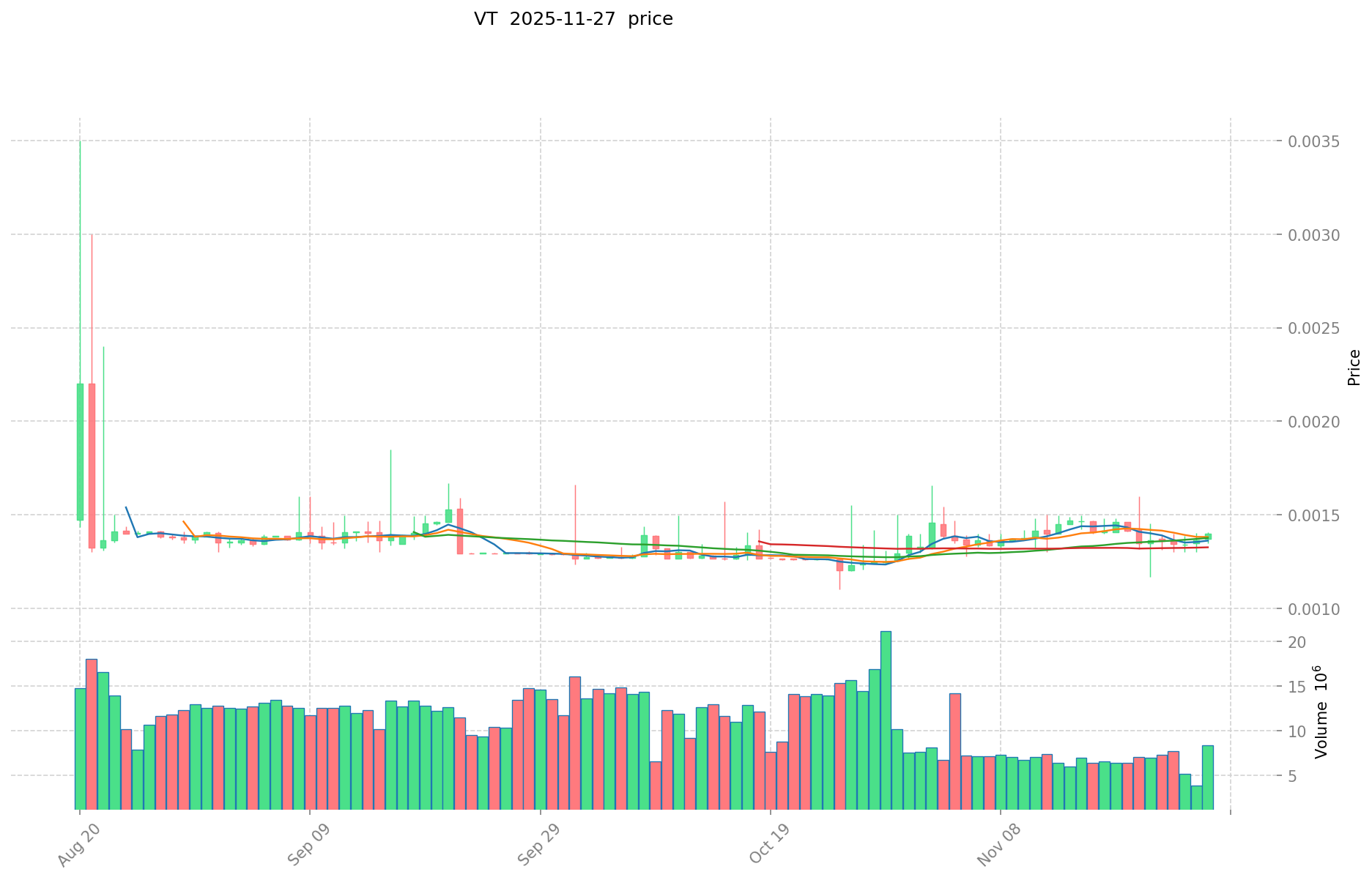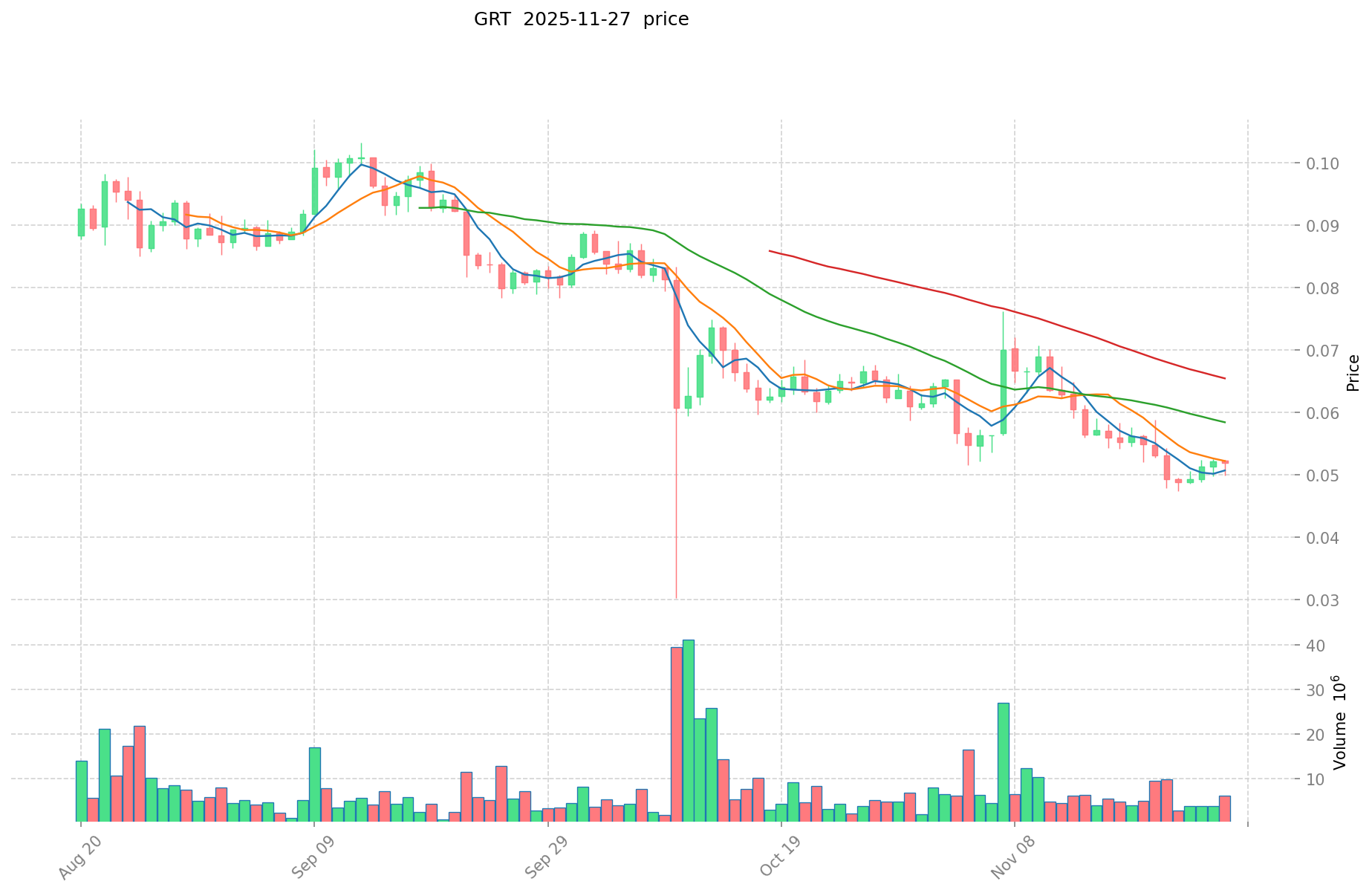VT vs GRT: Comparing Virtual Training and Group Real-Time Training Methods for Remote Teams
Introduction: VT vs GRT Investment Comparison
In the cryptocurrency market, the comparison between Vtrading (VT) and The Graph (GRT) remains an unavoidable topic for investors. The two not only show significant differences in market cap ranking, application scenarios, and price performance, but also represent different positioning in the crypto asset space.
Vtrading (VT): Since its launch in 2024, it has gained market recognition for its AI-driven quantitative trading services in the digital asset space.
The Graph (GRT): Introduced in 2020, it has been hailed as the "Google of blockchains," serving as one of the key infrastructures for indexing and querying blockchain data.
This article will comprehensively analyze the investment value comparison between VT and GRT, focusing on historical price trends, supply mechanisms, institutional adoption, technological ecosystems, and future predictions, attempting to answer the question investors are most concerned about:
"Which is the better buy right now?"
I. Price History Comparison and Current Market Status
VT and GRT Historical Price Trends
- 2024: VT reached its all-time high of $0.225 on May 28, 2024.
- 2025: VT hit its all-time low of $0.001026 on July 17, 2025, representing a significant drop from its peak.
- Comparative analysis: In this market cycle, VT has experienced a dramatic decline of approximately 99.3% from its all-time high to its all-time low. GRT has also seen a substantial decrease, falling from its all-time high of $2.84 to a current price of $0.05153, a decline of about 98.2%.
Current Market Situation (2025-11-27)
- VT current price: $0.001539
- GRT current price: $0.05153
- 24-hour trading volume: VT $11,787.46 vs GRT $205,606.03
- Market Sentiment Index (Fear & Greed Index): 22 (Extreme Fear)
Click to view real-time prices:
- Check VT current price Market Price
- Check GRT current price Market Price


II. Core Factors Affecting Investment Value of VT vs GRT
Supply Mechanism Comparison (Tokenomics)
- VT: Follows a gradual inflation model with token minting through staking rewards
- GRT: Implements a fixed supply of 10 billion tokens with deflationary mechanisms including burning of query fees
- 📌 Historical pattern: GRT's deflationary mechanism has created upward price pressure during periods of increased network usage, while VT's inflation model focuses on sustainable network security.
Institutional Adoption and Market Applications
- Institutional holdings: GRT has gained more institutional traction with integration into platforms like StreamingFast and Figment
- Enterprise adoption: GRT has stronger enterprise use through The Graph's indexing services for blockchain data across major ecosystems including Ethereum, Polygon, and Arbitrum
- Regulatory attitudes: Both tokens face varying regulatory treatment, with GRT's utility token classification potentially offering more regulatory clarity in certain jurisdictions
Technical Development and Ecosystem Building
- VT technical upgrades: Implementation of Proof of Stake consensus and validator network expansion
- GRT technical development: Expanded subgraph deployment capabilities, enhanced indexing protocols, and integration with multiple Layer 1 and Layer 2 networks
- Ecosystem comparison: GRT demonstrates stronger Web3 infrastructure positioning with over 34,000+ subgraphs and integration with numerous dApps, while VT focuses primarily on network security and staking applications
Macroeconomic Factors and Market Cycles
- Performance in inflationary environments: GRT's deflationary mechanism potentially offers better protection against inflation when network usage is high
- Macro monetary policy: Both tokens show correlation with broader crypto market reactions to Federal Reserve policies and interest rate changes
- Geopolitical factors: GRT benefits from increasing global demand for decentralized data infrastructure, while VT's value proposition is more focused on network participation
III. 2025-2030 Price Prediction: VT vs GRT
Short-term Prediction (2025)
- VT: Conservative $0.001235 - $0.001544 | Optimistic $0.001544 - $0.001961
- GRT: Conservative $0.028424 - $0.05168 | Optimistic $0.05168 - $0.059432
Mid-term Prediction (2027)
- VT may enter a growth phase, with prices expected in the range of $0.000983 - $0.002602
- GRT may enter a bullish market, with prices expected in the range of $0.0506 - $0.0936
- Key drivers: Institutional fund inflows, ETF developments, ecosystem growth
Long-term Prediction (2030)
- VT: Base scenario $0.001514 - $0.002912 | Optimistic scenario $0.002912 - $0.003961
- GRT: Base scenario $0.0517 - $0.0995 | Optimistic scenario $0.0995 - $0.1234
Disclaimer: The above predictions are based on historical data and market analysis. Cryptocurrency markets are highly volatile and subject to rapid changes. These projections should not be considered as financial advice. Always conduct your own research before making investment decisions.
VT:
| 年份 | 预测最高价 | 预测平均价格 | 预测最低价 | 涨跌幅 |
|---|---|---|---|---|
| 2025 | 0.00196088 | 0.001544 | 0.0012352 | 0 |
| 2026 | 0.002102928 | 0.00175244 | 0.0012617568 | 13 |
| 2027 | 0.0026023734 | 0.001927684 | 0.00098311884 | 25 |
| 2028 | 0.002650083579 | 0.0022650287 | 0.001721421812 | 47 |
| 2029 | 0.003366851911115 | 0.0024575561395 | 0.00152368480649 | 59 |
| 2030 | 0.003960597474418 | 0.002912204025307 | 0.001514346093159 | 89 |
GRT:
| 年份 | 预测最高价 | 预测平均价格 | 预测最低价 | 涨跌幅 |
|---|---|---|---|---|
| 2025 | 0.059432 | 0.05168 | 0.028424 | 0 |
| 2026 | 0.08111176 | 0.055556 | 0.03833364 | 7 |
| 2027 | 0.0936174156 | 0.06833388 | 0.0505670712 | 32 |
| 2028 | 0.08907321258 | 0.0809756478 | 0.062351248806 | 57 |
| 2029 | 0.1139327364546 | 0.08502443019 | 0.0467634366045 | 64 |
| 2030 | 0.123353443319652 | 0.0994785833223 | 0.051728863327596 | 93 |
IV. Investment Strategy Comparison: VT vs GRT
Long-term vs Short-term Investment Strategies
- VT: Suitable for investors focused on network participation and staking rewards
- GRT: Suitable for investors interested in Web3 infrastructure and data indexing potential
Risk Management and Asset Allocation
- Conservative investors: VT: 30% vs GRT: 70%
- Aggressive investors: VT: 40% vs GRT: 60%
- Hedging tools: Stablecoin allocation, options, cross-token portfolio diversification
V. Potential Risk Comparison
Market Risks
- VT: High volatility, limited market history
- GRT: Correlation with broader crypto market trends, competition in the indexing space
Technical Risks
- VT: Scalability, network stability
- GRT: Indexing efficiency, potential vulnerabilities in subgraph deployments
Regulatory Risks
- Global regulatory policies may have differing impacts on both tokens, with GRT potentially benefiting from its utility token classification in some jurisdictions
VI. Conclusion: Which Is the Better Buy?
📌 Investment Value Summary:
- VT advantages: AI-driven quantitative trading focus, potential for growth in emerging market
- GRT advantages: Established position in blockchain data indexing, wider ecosystem adoption
✅ Investment Recommendations:
- Novice investors: Consider a higher allocation to GRT due to its more established market position
- Experienced investors: Balanced approach with exposure to both tokens, leveraging VT's growth potential
- Institutional investors: Focus on GRT for its infrastructure role in the Web3 ecosystem, with strategic allocation to VT for diversification
⚠️ Risk Warning: Cryptocurrency markets are highly volatile. This article does not constitute investment advice. None
VII. FAQ
Q1: What are the key differences between VT and GRT? A: VT focuses on AI-driven quantitative trading services in the digital asset space, while GRT serves as a key infrastructure for indexing and querying blockchain data. GRT has a more established market position and wider ecosystem adoption, while VT is a newer entrant with potential for growth in emerging markets.
Q2: How do the tokenomics of VT and GRT compare? A: VT follows a gradual inflation model with token minting through staking rewards. GRT, on the other hand, has a fixed supply of 10 billion tokens with deflationary mechanisms, including burning of query fees.
Q3: Which token has shown better price performance historically? A: Both tokens have experienced significant declines from their all-time highs. VT has seen a 99.3% drop from its peak, while GRT has declined by about 98.2% from its all-time high.
Q4: What are the main risk factors for each token? A: VT faces risks such as high volatility and limited market history. GRT's risks include correlation with broader crypto market trends and competition in the indexing space. Both tokens are subject to regulatory risks, which may impact them differently.
Q5: How do the long-term price predictions for VT and GRT compare? A: By 2030, VT is predicted to reach $0.001514 - $0.003961 in various scenarios, while GRT is expected to reach $0.0517 - $0.1234. These predictions suggest potentially higher percentage gains for VT, but from a much lower base price.
Q6: Which token is more suitable for different types of investors? A: Novice investors might consider a higher allocation to GRT due to its more established market position. Experienced investors could take a balanced approach with exposure to both tokens. Institutional investors might focus more on GRT for its infrastructure role in the Web3 ecosystem.
Q7: How do institutional adoption and market applications differ between VT and GRT? A: GRT has gained more institutional traction and has stronger enterprise use through its indexing services for blockchain data across major ecosystems. VT's adoption is more focused on network participation and staking applications.
Share
Content